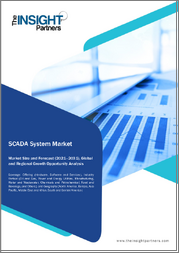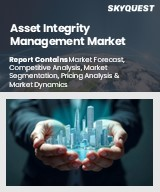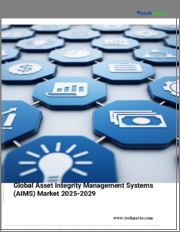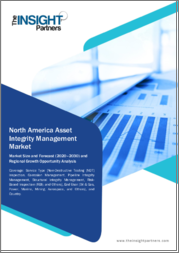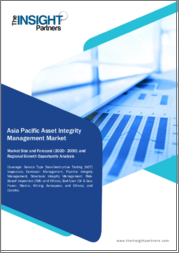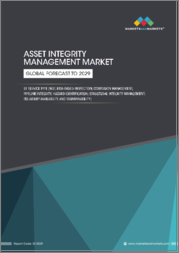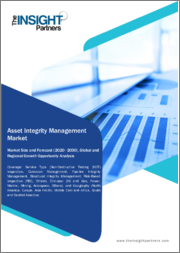
|
시장보고서
상품코드
1479860
자산 무결성 관리 시장 - 예측(2024-2029년)Asset Integrity Management Market - Forecasts from 2024 to 2029 |
||||||
자산 무결성 관리 시장은 2022년 244억 1,600만 달러로 평가되며, 연평균 9.10% 성장하여 2029년에는 449억 2,400만 달러의 시장 규모에 도달할 것으로 예상됩니다.
자산 무결성 관리(AIM)는 건강, 보안, 환경을 보호하면서 중요한 자산과 시스템의 가용성을 확인하기 위한 체계적이고 협력적인 활동에 사용되는 서비스 및 소프트웨어를 말합니다. 불안정한 프로세스를 실행하는 많은 공장은 안전을 보장하기 위해 자산 무결성을 더 많이 고려하기 시작했습니다.
여러 비즈니스의 최종사용자들은 보안 관행을 확립하고 있습니다. 또한 일부 전통적인 조직은 최종사용자에게 더 명확한 체계를 구현하기 위해 새로운 조치를 취하고 있습니다. 여러 유명 산업 사고로 인한 산업 사고의 위협은 규제 당국이 더 엄격한 안전 규정을 제정하고 이러한 규정을 더 잘 이행하기 위한 노력을 기울이게 하는 계기가 되었습니다.
시장 동향:
AIM(자산 무결성 관리)은 여러 가지 주요 요인에 의해 주도되고 있습니다. 엄격한 규제로 인해 다양한 기업들이 안전 및 환경 기준 준수를 보장하는 AIM 솔루션에 투자할 수밖에 없는 상황입니다. 일부 산업에서는 인프라의 노후화로 인해 자산의 수명주기를 연장하고 고장을 방지하기 위해 적극적인 유지보수 대책이 필요하며, 이는 자산의 수명주기를 연장하고 고장을 방지하는 데 도움이 됩니다. AIM 기술은 유지보수 일정을 최대화하고 다운타임 비용을 줄임으로써 비용 절감과 운영 효율성을 높일 수 있는 기회를 제공합니다.
또한, 산업 자산이 복잡해짐에 따라 자산을 적절히 관리하기 위해서는 디지털 트윈이나 예지보전과 같은 첨단 AIM 기술이 필요합니다. 또한, AIM 솔루션을 사용하여 운영 위험을 줄이고 안전 조치를 개선하는 것은 안전과 위험 관리의 중요성에 대한 동기를 부여합니다.
시장 촉진요인:
- 석유 및 가스 가격의 상승은 시장 성장을 촉진할 것으로 예상됩니다.
자산 무결성 관리 시장의 성장을 촉진하는 주요 요인은 석유 및 가스 가격의 급락으로 여러 사업부문에 걸친 기업의 플랜트 및 자산 유지보수에 대한 요구가 증가하고 있습니다. 또한 심해에서 자산 무결성 관리를 필요로 하는 새로운 해양 유전이 등장하면서 시장 확대에 큰 영향을 미치고 있습니다. 자산 무결성 관리 서비스는 업계에서 유지보수 프로토콜과 리프트 검사 프로세스의 기록을 보관하기 위해 광범위하게 채택될 가능성이 있습니다.
자산 무결성 관리에 대한 요구는 유전의 자본 지출을 완화해야 한다는 인식이 높아짐에 따라 증가할 것으로 예상됩니다. 자산 무결성 관리 시장의 중요한 원동력 중 하나는 여러 산업에서 노후화된 자산의 노후화로 인해 운영 안전이 절실히 요구되고 있다는 점입니다. 또한, 기후 변화는 석유 및 가스 인프라, 탱크, 파이프라인, 선박 등 여러 자산의 견고성에 영향을 미칠 수 있습니다. 자산의 건전성이 제대로 유지되지 않으면 인간의 삶과 환경을 파괴하고, 나아가 산업 전체의 재정적 측면에도 영향을 미칠 수 있습니다. 따라서 많은 국가의 정부는 산업이 안전하게 공정에 종사할 수 있도록 엄격한 품질 관리 조치와 안전법을 도입하고 있습니다.
- 인프라 노후화는 자산 무결성 관리 시장의 성장에 영향을 미칠 것으로 예상됩니다.
자산 무결성 관리 시장(AIM)은 인프라 노후화로 인해 확대되고 있습니다. 운송, 발전, 석유 및 가스 등 다양한 산업에서 중요한 인프라 자산의 신뢰성, 안전성 및 규제 준수를 유지하기 위해 사전 예방적 관리가 점점 더 중요해지고 있습니다. 노후화된 인프라에서 부식, 마모 및 기타 열화는 자산 고장, 안전 사고 및 값비싼 다운타임의 원인이 될 수 있습니다. 이에 따라 각 부문은 자산의 상태를 추적하고, 고장을 예측하고, 유지보수 작업을 지시하기 위해 강력한 AIM 계획과 기술을 도입하는 것이 얼마나 중요한지 인식하고 있습니다.
시장 억제요인:
열악한 운영 환경, 증가하는 운영 비용, 예측할 수 없는 기후 조건, 숙련된 인력 부족 등이 자산 무결성 관리 시장의 성장을 저해하는 요인으로 작용하고 있습니다.
복잡한 인프라와 노후화된 자산은 업계의 총비용을 증가시킵니다. 또한, 석유 및 가스 업스트림 산업은 높은 기능 비용과 석유 가격의 하락으로 인해 자산 무결성 관리 시장의 큰 장애물이 되고 있습니다. 마찬가지로, 석유 및 가스 다운스트림 산업은 상품에 대한 엄청난 수요와 합리적인 원자재 가용성으로 인해 최적의 잠재력으로 운영되고 있습니다. 그 결과, 석유 및 가스 다운스트림 산업은 노후화된 자산의 생산 가동 시간을 유지하기 위해 고군분투하고 있습니다.
이러한 상황에서 자산 무결성 관리는 기업의 운영 비용을 증가시킬 것으로 예상됩니다. 또한 개발도상국 및 전력 다소비 산업의 에너지 수요 증가로 인해 업스트림 부문에서 활동하는 석유 및 가스 개발 기업들은 더 깊고 먼 바다에서 해양 탐사를 할 수밖에 없으며, 이는 수압 및 환경 조건의 한계로 이어지고 있습니다. 중동과 북극 지역은 이미 기상 조건이 열악하고, 북극 지역은 연중 큰 변동성을 보이는 민감한 환경이기 때문에 계속 변화하는 상황 속에서 필요한 데이터를 축적하는 데 필요한 탐사 장비와 장비의 종류에 장애가 되고 있습니다. 따라서 혹독한 환경은 자산 무결성 관리 서비스의 성능에 영향을 미치고 시장 성장을 제한하는 근본적인 요인으로 작용하고 있습니다.
북미는 주요 지역 시장이 될 것으로 예상됩니다.
북미의 시장 성장은 자산의 무결성 유지, 안전 및 환경 보호에 대한 정부 이니셔티브, IoT 및 자동화 인식 프로그램 증가, 제품의 비용 효율성이 북미 시장 성장에 박차를 가하고 있습니다.
북미 자산 무결성 관리(AIM) 산업의 주요 촉진요인은 몇 가지 중요한 측면이 있습니다. 예를 들어, 미국석유협회(API) 및 산업안전보건청(OSHA)과 같은 기관에서 제정한 엄격한 규제 프레임워크로 인해 기업들은 안전, 환경 및 품질 요건 준수를 보장하기 위해 AIM 솔루션에 투자할 수밖에 없습니다. 또한, 특히 석유 및 가스, 발전, 운송 분야에서는 노후화된 인프라로 인한 자산의 노후화, 고장 및 안전사고의 위험을 줄이기 위해 적극적인 유지보수 대책이 요구되고 있으며, 이는 시장 확대를 촉진하고 있습니다.
주요 발전
- 2023년 11월, 인프라 엔지니어링 소프트웨어 기업인 Bentley Systems, Incorporated는 BP가 Bentley Infrastructure Cloud의 일부인 Bentley의 AssetWise Asset Lifecycle Information Management(ALIM) 및 AssetWise Reliability(AR)를 사용하여 프로젝트 및 운영 엔지니어링 정보를 관리하여 세계 자산 무결성 관리를 지원하기로 결정했다고 발표했습니다.
- 2022년 8월, InnetiQs GmbH(IQ)와 Oceaneering International은 해양 및 육상 에너지 산업을 위한 혁신적인 검사 솔루션을 연구하고 개발하기 위해 파트너십 계약을 체결했습니다. 이번 파트너십을 통해 Oceaneering의 세계 사업과 IQ의 해저 파이프라인, 라이저 및 구조물 자산을 위한 최첨단 검사 기술과 결합하여 작업자의 피폭 위험을 줄이는 비용 효율적이고 면밀한 검사 및 세척 프로세스를 결합할 예정입니다.
목차
제1장 소개
- 시장 개요
- 시장 정의
- 조사 범위
- 시장 세분화
- 통화
- 가정
- 기준 연도와 예측 연도 타임라인
- 이해관계자에 대한 주요 이점
제2장 조사 방법
- 조사 디자인
- 조사 과정
제3장 주요 요약
- 주요 조사 결과
- 애널리스트의 견해
제4장 시장 역학
- 시장 성장 촉진요인
- 시장 성장 억제요인
- Porter's Five Forces 분석
- 업계 밸류체인 분석
- 애널리스트의 견해
제5장 자산 무결성 관리 시장 : 서비스별
- 소개
- RBI
- 시장 동향과 기회
- 성장 전망
- 지리적인 이익성
- RAM 연구
- 시장 동향과 기회
- 성장 전망
- 지리적인 이익성
- 부식 관리
- 시장 동향과 기회
- 성장 전망
- 지리적인 이익성
- 파이프라인 무결성 관리
- 시장 동향과 기회
- 성장 전망
- 지리적인 이익성
- 하지드 연구
- 시장 동향과 기회
- 성장 전망
- 지리적인 이익성
- 구조 무결성 관리
- 시장 동향과 기회
- 성장 전망
- 지리적인 이익성
- 비파괴 검사
- 시장 동향과 기회
- 성장 전망
- 지리적인 이익성
- 기타
- 시장 동향과 기회
- 성장 전망
- 지리적인 이익성
제6장 자산 무결성 관리 시장 : 업계별
- 소개
- 석유·가스
- 시장 동향과 기회
- 성장 전망
- 지리적인 이익성
- 에너지와 전력
- 시장 동향과 기회
- 성장 전망
- 지리적인 이익성
- 광업
- 시장 동향과 기회
- 성장 전망
- 지리적인 이익성
- 화학제품
- 시장 동향과 기회
- 성장 전망
- 지리적인 이익성
- 항공우주
- 시장 동향과 기회
- 성장 전망
- 지리적인 이익성
- 기타
- 시장 동향과 기회
- 성장 전망
- 지리적인 이익성
제7장 자산 무결성 관리 시장 : 지역별
- 소개
- 북미
- 서비스별
- 업계별
- 국가별
- 남미
- 유럽
- 중동 및 아프리카
- 아시아태평양
제8장 경쟁 환경과 분석
- 주요 기업과 전략 분석
- 시장 점유율 분석
- 합병, 인수, 합의 및 협업
- 경쟁 대시보드
제9장 기업 개요
- SGS SA
- Bureau Veritas SA(Wendel)
- Intertek Group plc
- TechnipFMC plc(FMC Technologies)
- Aker Solutions ASA
- Applus+
- John Wood Group PLC
- Oceaneering International, Inc.
- Fluor Corporation
- LifeTech Engineering Ltd.
The Asset integrity management market is evaluated at US$24.416 billion for the year 2022 and is projected to grow at a CAGR of 9.10% to reach a market size of US$44.924 billion by the year 2029.
Asset integrity management (AIM) refers to the services and software used in systematic and coordinated activities to confirm the availability of significant assets and systems while protecting health, security, and the environment. Many factories that perform precarious processes have begun to give more consideration to asset integrity for its purpose of assuring safety.
End users in multiple businesses are establishing security practices. Several conventional bodies have also ascertained new measures to implement a better-defined structure for end-users. The threat of an industrial accident in the wake of various high-profile misfortunes has also advanced regulatory authorities to inflict more stringent safety ordinances as well as advance efforts to better implement these regulations.
MARKET TRENDS:
AIM (asset integrity management) is driven by many major factors. Various companies are forced by strict regulations to invest in AIM solutions to guarantee adherence to safety and environmental norms. To prolong asset lifecycles and avert breakdowns, proactive maintenance measures are required due to the aging infrastructure across several industries. By maximizing maintenance schedules and lowering downtime expenses, AIM techniques provide chances for cost savings and operational effectiveness.
Furthermore, to properly manage assets, advanced AIM technologies like digital twins and predictive maintenance are required due to the growing complexity of industrial assets. Additionally, the use of AIM solutions to reduce operational risks and improve safety measures is motivated by the focus on safety and risk management.
MARKET DRIVERS:
- A rise in oil and gas prices is anticipated to drive the market's growth.
The main factor driving the growth of the asset integrity management market is the plunge in oil and gas prices, which is increasing the requirement for the maintenance of company plants and assets across multiple businesses. New offshore fields demanding asset integrity management in deep waters could additionally be a significant determinant of the growing market. Asset integrity management services could be profoundly employed to keep a record of maintenance protocols and lift inspection processes in the industry.
The requirement for asset integrity management is forecasted to increase due to the growing realization of a moderating capital outlay in oil fields. One of the important driving determinants of the asset integrity management market is the dire necessity for operational safety because of the deterioration of old assets in multiple industries. Besides, climate variation influences the solidarity of several assets, such as oil and gas infrastructure, tanks, pipelines, and vessels. Incorrect sustenance of asset integrity disrupts human life and the environment and additionally affects the financial aspect of the whole industry. Therefore, the governments of many countries are introducing severe quality control measures and safety laws for industries to securely engage in processes.
- Aging infrastructure is predicted to impact the asset integrity management market growth.
The asset integrity management market, or AIM, is expanding as a result of the aging infrastructure. To maintain the dependability, safety, and regulatory compliance of vital infrastructure assets across a range of industries, including transportation, power generation, and oil and gas, proactive management is becoming more and more important. Corrosion, wear and tear, and other types of degradation can cause asset failures, safety accidents, and expensive downtime in infrastructure that is getting older. As a result, sectors are realizing how crucial it is to put strong AIM plans and technologies in place to track asset health, anticipate any breakdowns, and order maintenance tasks.
MARKET RESTRAINTS:
Severe operating circumstances, growing operating costs, unpredictable climatic conditions, and lack of skilled laborers are key factors that act as restraints for the growth of the asset integrity management market.
Frequently, complicated infrastructure and deteriorating assets add to the total cost of the industry. Adding to this, the upstream oil and gas industry suffers from high functioning costs and low oil prices, which are regarded as significant hindrances to the asset integrity management market. Likewise, the downstream oil and gas industry operates at its optimal potential owing to the huge demand for its commodities and the availability of reasonable feedstock. As a consequence, the downstream oil and gas industry fights to bear the production uptime of its aging assets.
Under these conditions, asset integrity management is expected to increase the operating cost of the company. Also, the growing demand for energy from developing countries and power-intensive industries has forced oil and gas exploration companies functioning in the upstream sector to explore deeper and farther offshore into the ocean, and this leads to water pressure and the limit of environmental conditions. The Middle East and Arctic regions already have severe weather situations, and the Arctic region has a sensitive environment with substantial year-round fluctuations, which pose hurdles for investigation devices and types of equipment to accumulate the needed data over some time as the conditions continue shifting. Therefore, severe functioning circumstances affect the performance of asset integrity management services, which acts as a fundamental factor that limits the growth of the market.
North America is anticipated to be the major regional market.
The growth of the market in the North American region can also be attributed to the initiatives by the government on the maintenance of the integrity of assets, ensuring safety, and environmental preservation. The growing awareness programs about IoT and automation, and the cost-effectiveness of the products, add to the growth of the market in North America.
Several important aspects are the main drivers of the asset integrity management (AIM) industry in North America. For instance, enterprises are forced to invest in AIM solutions to guarantee adherence to safety, environmental, and quality requirements by means of the strict regulatory frameworks established by agencies like the American Petroleum Institute (API) and the Occupational Safety and Health Administration (OSHA). Furthermore, proactive maintenance measures are required to reduce the risks of asset degradation, failures, and safety events due to the ageing infrastructure in the area, especially in the oil and gas, power generating, and transportation sectors which in turn fuels the market expansion.
Key Developments:
- In November 2023, the infrastructure engineering software company Bentley Systems, Incorporated announced that BP has chosen to manage engineering information for projects and operations to help ensure global asset integrity management using Bentley's AssetWise Asset Lifecycle Information Management (ALIM) and AssetWise Reliability (AR), both of which are part of Bentley Infrastructure Cloud.
- In August 2022, InnetiQs GmbH (IQ) and Oceaneering International established a partnership agreement to investigate and develop innovative inspection solutions for the offshore and onshore energy industries. Through this joint partnership, Oceaneering's worldwide operations and cost-effective, in-depth inspection and cleaning processes that reduce worker exposure hazards are combined with IQ's cutting-edge inspection technology for subsea pipelines, risers, and structural assets.
Segmentation:
By Service
- RBI
- RAM Study
- Corrosion Management
- Pipeline Integrity Management
- Hazid Study
- Structural Integrity Management
- NDT
- Others
By Industry
- Oil & Gas
- Energy & Power
- Mining
- Chemical
- Aerospace
- Others
By Geography
- North America
- USA
- Canada
- Mexico
- South America
- Brazil
- Argentina
- Others
- Europe
- United Kingdom
- Germany
- France
- Spain
- Others
- Middle East and Africa
- Saudi Arabia
- UAE
- Israel
- Others
- Asia Pacific
- China
- Japan
- India
- South Korea
- Taiwan
- Thailand
- Indonesia
- Others
TABLE OF CONTENTS
1. INTRODUCTION
- 1.1. Market Overview
- 1.2. Market Definition
- 1.3. Scope of the Study
- 1.4. Market Segmentation
- 1.5. Currency
- 1.6. Assumptions
- 1.7. Base, and Forecast Years Timeline
- 1.8. Key Benefits for the stakeholder
2. RESEARCH METHODOLOGY
- 2.1. Research Design
- 2.2. Research Processes
3. EXECUTIVE SUMMARY
- 3.1. Key Findings
- 3.2. Analyst View
4. MARKET DYNAMICS
- 4.1. Market Drivers
- 4.2. Market Restraints
- 4.3. Porter's Five Forces Analysis
- 4.3.1. Bargaining Power of Suppliers
- 4.3.2. Bargaining Power of Buyers
- 4.3.3. Threat of New Entrants
- 4.3.4. Threat of Substitutes
- 4.3.5. Competitive Rivalry in the Industry
- 4.4. Industry Value Chain Analysis
- 4.5. Analyst View
5. ASSET INTEGRITY MANAGEMENT MARKET, BY SERVICE
- 5.1. Introduction
- 5.2. RBI
- 5.2.1. Market Trends and Opportunities
- 5.2.2. Growth Prospects
- 5.2.3. Geographic Lucrativeness
- 5.3. RAM Study
- 5.3.1. Market Trends and Opportunities
- 5.3.2. Growth Prospects
- 5.3.3. Geographic Lucrativeness
- 5.4. Corrosion Management
- 5.4.1. Market Trends and Opportunities
- 5.4.2. Growth Prospects
- 5.4.3. Geographic Lucrativeness
- 5.5. Pipeline Integrity Management
- 5.5.1. Market Trends and Opportunities
- 5.5.2. Growth Prospects
- 5.5.3. Geographic Lucrativeness
- 5.6. Hazid Study
- 5.6.1. Market Trends and Opportunities
- 5.6.2. Growth Prospects
- 5.6.3. Geographic Lucrativeness
- 5.7. Structural Integrity Management
- 5.7.1. Market Trends and Opportunities
- 5.7.2. Growth Prospects
- 5.7.3. Geographic Lucrativeness
- 5.8. NDT
- 5.8.1. Market Trends and Opportunities
- 5.8.2. Growth Prospects
- 5.8.3. Geographic Lucrativeness
- 5.9. Others
- 5.9.1. Market Trends and Opportunities
- 5.9.2. Growth Prospects
- 5.9.3. Geographic Lucrativeness
6. ASSET INTEGRITY MANAGEMENT MARKET, BY INDUSTRY
- 6.1. Introduction
- 6.2. Oil & Gas
- 6.2.1. Market Trends and Opportunities
- 6.2.2. Growth Prospects
- 6.2.3. Geographic Lucrativeness
- 6.3. Energy & Power
- 6.3.1. Market Trends and Opportunities
- 6.3.2. Growth Prospects
- 6.3.3. Geographic Lucrativeness
- 6.4. Mining
- 6.4.1. Market Trends and Opportunities
- 6.4.2. Growth Prospects
- 6.4.3. Geographic Lucrativeness
- 6.5. Chemical
- 6.5.1. Market Trends and Opportunities
- 6.5.2. Growth Prospects
- 6.5.3. Geographic Lucrativeness
- 6.6. Aerospace
- 6.6.1. Market Trends and Opportunities
- 6.6.2. Growth Prospects
- 6.6.3. Geographic Lucrativeness
- 6.7. Others
- 6.7.1. Market Trends and Opportunities
- 6.7.2. Growth Prospects
- 6.7.3. Geographic Lucrativeness
7. ASSET INTEGRITY MANAGEMENT MARKET, BY GEOGRAPHY
- 7.1. Introduction
- 7.2. North America
- 7.2.1. By Service
- 7.2.2. By Industry
- 7.2.3. By Country
- 7.2.3.1. USA
- 7.2.3.1.1. Market Trends and Opportunities
- 7.2.3.1.2. Growth Prospects
- 7.2.3.2. Canada
- 7.2.3.2.1. Market Trends and Opportunities
- 7.2.3.2.2. Growth Prospects
- 7.2.3.3. Mexico
- 7.2.3.3.1. Market Trends and Opportunities
- 7.2.3.3.2. Growth Prospects
- 7.2.3.1. USA
- 7.3. South America
- 7.3.1. By Service
- 7.3.2. By Industry
- 7.3.3. By Country
- 7.3.3.1. Brazil
- 7.3.3.1.1. Market Trends and Opportunities
- 7.3.3.1.2. Growth Prospects
- 7.3.3.2. Argentina
- 7.3.3.2.1. Market Trends and Opportunities
- 7.3.3.2.2. Growth Prospects
- 7.3.3.3. Others
- 7.3.3.3.1. Market Trends and Opportunities
- 7.3.3.3.2. Growth Prospects
- 7.3.3.1. Brazil
- 7.4. Europe
- 7.4.1. By Service
- 7.4.2. By Industry
- 7.4.3. By Country
- 7.4.3.1. United Kingdom
- 7.4.3.1.1. Market Trends and Opportunities
- 7.4.3.1.2. Growth Prospects
- 7.4.3.2. Germany
- 7.4.3.2.1. Market Trends and Opportunities
- 7.4.3.2.2. Growth Prospects
- 7.4.3.3. France
- 7.4.3.3.1. Market Trends and Opportunities
- 7.4.3.3.2. Growth Prospects
- 7.4.3.4. Spain
- 7.4.3.4.1. Market Trends and Opportunities
- 7.4.3.4.2. Growth Prospects
- 7.4.3.5. Others
- 7.4.3.5.1. Market Trends and Opportunities
- 7.4.3.5.2. Growth Prospects
- 7.4.3.1. United Kingdom
- 7.5. Middle East and Africa
- 7.5.1. By Service
- 7.5.2. By Industry
- 7.5.3. By Country
- 7.5.3.1. Saudi Arabia
- 7.5.3.1.1. Market Trends and Opportunities
- 7.5.3.1.2. Growth Prospects
- 7.5.3.2. UAE
- 7.5.3.2.1. Market Trends and Opportunities
- 7.5.3.2.2. Growth Prospects
- 7.5.3.3. Israel
- 7.5.3.3.1. Market Trends and Opportunities
- 7.5.3.3.2. Growth Prospects
- 7.5.3.4. Others
- 7.5.3.4.1. Market Trends and Opportunities
- 7.5.3.4.2. Growth Prospects
- 7.5.3.1. Saudi Arabia
- 7.6. Asia Pacific
- 7.6.1. By Service
- 7.6.2. By Industry
- 7.6.3. By Country
- 7.6.3.1. China
- 7.6.3.1.1. Market Trends and Opportunities
- 7.6.3.1.2. Growth Prospects
- 7.6.3.2. Japan
- 7.6.3.2.1. Market Trends and Opportunities
- 7.6.3.2.2. Growth Prospects
- 7.6.3.3. India
- 7.6.3.3.1. Market Trends and Opportunities
- 7.6.3.3.2. Growth Prospects
- 7.6.3.4. South Korea
- 7.6.3.4.1. Market Trends and Opportunities
- 7.6.3.4.2. Growth Prospects
- 7.6.3.5. Taiwan
- 7.6.3.5.1. Market Trends and Opportunities
- 7.6.3.5.2. Growth Prospects
- 7.6.3.6. Thailand
- 7.6.3.6.1. Market Trends and Opportunities
- 7.6.3.6.2. Growth Prospects
- 7.6.3.7. Indonesia
- 7.6.3.7.1. Market Trends and Opportunities
- 7.6.3.7.2. Growth Prospects
- 7.6.3.8. Others
- 7.6.3.8.1. Market Trends and Opportunities
- 7.6.3.8.2. Growth Prospects
- 7.6.3.1. China
8. COMPETITIVE ENVIRONMENT AND ANALYSIS
- 8.1. Major Players and Strategy Analysis
- 8.2. Market Share Analysis
- 8.3. Mergers, Acquisitions, Agreements, and Collaborations
- 8.4. Competitive Dashboard
9. COMPANY PROFILES
- 9.1. SGS SA
- 9.2. Bureau Veritas SA (Wendel)
- 9.3. Intertek Group plc
- 9.4. TechnipFMC plc (FMC Technologies)
- 9.5. Aker Solutions ASA
- 9.6. Applus+
- 9.7. John Wood Group PLC
- 9.8. Oceaneering International, Inc.
- 9.9. Fluor Corporation
- 9.10. LifeTech Engineering Ltd.






